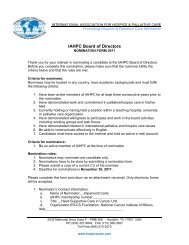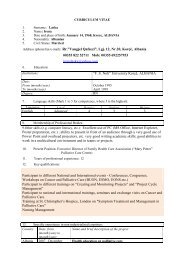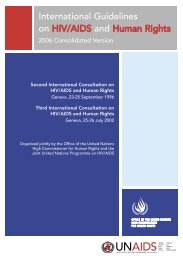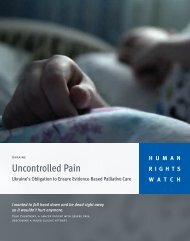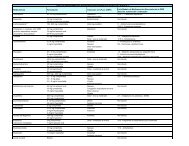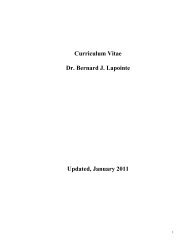INTERIGHTS Bulletin
INTERIGHTS Bulletin
INTERIGHTS Bulletin
You also want an ePaper? Increase the reach of your titles
YUMPU automatically turns print PDFs into web optimized ePapers that Google loves.
<strong>INTERIGHTS</strong> <strong>Bulletin</strong><br />
Volume 16 Number 4 2011<br />
193<br />
non-existent judicial review or any<br />
opportunities to challenge the<br />
detention, raising considerable<br />
concerns with respect to due process<br />
protections and arbitrary detention.<br />
Treatment centres are often run by the<br />
military or security services with little<br />
or no training in health care. 61 Severe<br />
beatings, sexual violence and other<br />
forms of torture have been<br />
documented 62 as well as widespread<br />
forced labour. 63<br />
In Cambodia where Human Rights<br />
Watch documented sexual assaults,<br />
people being shocked with electric<br />
batons and beaten with twisted<br />
electrical wire, nearly one-quarter of<br />
detainees in government treatment<br />
centres were under 18-years-old. 64 In<br />
another ‘treatment centre’ in Laos –<br />
that was lined with razor wire fences<br />
and guards to prevent escapes –<br />
Human Rights Watch noted that the<br />
facility served as a ‘dumping ground’<br />
for the homeless, street children and<br />
people with mental disabilities. 65 In<br />
Vietnam, where tens of thousands of<br />
drug users are held in detention at any<br />
one time, people were forced to work<br />
under threat of violence or isolation. 66<br />
Even those who entered voluntarily for<br />
treatment were not allowed to leave –<br />
sometimes for years. 67<br />
Corporal Punishment<br />
Judicial corporal punishment – the<br />
state-sanctioned beating, caning or<br />
whipping of a person for drug use,<br />
purchase or possession – represents<br />
everything harm reduction opposes. 68<br />
It is a cruel and inhuman punishment<br />
and is absolutely prohibited in<br />
international law. 69 Despite this fact,<br />
institutionalised, state-sanctioned,<br />
violence is commonly applied to drug<br />
and alcohol offences. Whipping,<br />
flogging or caning is often carried out<br />
in public to escalate feelings of shame<br />
and humiliation. It is intentional<br />
degradation. Aside from the physical<br />
damage, the result can be long-lasting<br />
psychological trauma for those<br />
punished in this manner. 70<br />
Harm Reduction International has<br />
produced a study of the legal basis for<br />
judicial corporal punishment for drug<br />
and alcohol offences in twelve<br />
jurisdictions. In relation to drug and<br />
alcohol offences, including those for<br />
consumption and for relapse from<br />
treatment, corporal punishment is<br />
prescribed in some jurisdictions as<br />
either a main punishment or in<br />
addition to imprisonment. Judicial<br />
corporal punishment for drugs and<br />
alcohol offences is applied in both<br />
secular and religious states. 71<br />
By definition, harm reduction centres<br />
on reducing the harms associated with<br />
drugs and their use. It requires<br />
engaging drug users in order to<br />
understand their needs for their health<br />
and for the general well-being of their<br />
families, communities and society.<br />
However, it can only function if people<br />
are not fearful of suffering negative<br />
consequences or outright abuse; if<br />
people are not frightened of being<br />
whipped or caned, forced into<br />
detention against their will, subject to<br />
forced labour, placed on registries that<br />
can negatively impact their own wellbeing<br />
and that of their families, or<br />
suffer from extortion or other abuses<br />
by those in power. These practices<br />
serve as structural barriers to engaging<br />
with people who use drugs, to<br />
providing services that will promote<br />
their health and well-being and benefit<br />
society at large, and to realising their<br />
right to health.<br />
Conclusion<br />
Harm reduction has over two decades<br />
of scientific evidence supporting it. But<br />
evidence has never been enough.<br />
Human rights support for harm<br />
reduction is newer and still<br />
developing. But it is an important<br />
development, engaging international<br />
law and new mechanisms, and<br />
involving new partners and ways of<br />
advocating for those interventions that<br />
are known to work best.<br />
Drug policies should be seen as a<br />
thematic issue in human rights<br />
discourse. It is a surprise that they still<br />
are not. But as the issues above and<br />
others are focused on more and more<br />
it is in increasingly likely that this will<br />
happen. People who use drugs do not<br />
forfeit their right to health, life, privacy<br />
or humane treatment nor does the<br />
presence of drugs in society serve as a<br />
legitimate exception to a state’s<br />
obligation to respect citizens’ freedom<br />
from arbitrary detention and other<br />
abuses. This has been made explicit by<br />
international bodies entrusted with the<br />
implementation of human rights<br />
treaties. The jurisprudence and<br />
scholarship around the human rights<br />
dimensions of harm reduction will be<br />
a critical component in understanding<br />
not just what works to protect people<br />
and society from drug-related harms,<br />
but what is appropriate and necessary<br />
in a democratic society to achieve this<br />
legitimate aim.<br />
Damon Barrett is Senior Analyst:<br />
Human Rights and Patrick Gallahue is<br />
Human Rights Analyst at Harm<br />
Reduction International.<br />
* Formerly the International Harm Reduction<br />
Association.<br />
1 What is Harm Reduction Harm Reduction<br />
International, 2010, available at .<br />
2 Ibid.<br />
3 C. Cook (ed), Global State of Harm Reduction 2010,<br />
Harm Reduction International, 2010,) available at<br />
.<br />
4 WHO Model List of Essential Medicines, 17th list,<br />
March 2011, available at: .<br />
5 WHO, UNODC, UNAIDS, Technical Guide for countries<br />
to set targets for universal access to HIV<br />
prevention, treatment and care for injecting drug users,<br />
2009, available at: .<br />
6 T. Rhodes, 'The ‘risk environment’: a framework for<br />
understanding and reducing drug-related harm' 13<br />
International Journal of Drug Policy (2002) 85-94.<br />
7 S. Strathdee et al ‘HIV and risk environment for injecting<br />
drug users: the past, present, and future’ The<br />
Lancet, Volume 376, Issue 9737, Pages 268 - 284, 24<br />
July 2010.<br />
8 Supra note 1.<br />
9 R. Jurgens and G. Betteridge ‘HIV Prevention for<br />
Prisoners: A Public Health and Human Rights<br />
Perspective’ and J. Csete ‘Is the UN Providing<br />
Leadership on HIV/AIDS and Human Rights’,<br />
<strong>INTERIGHTS</strong> <strong>Bulletin</strong>, Volume 15, Issue 2: HIV/AIDS<br />
and Human Rights (September 2005).<br />
10 UN Committee on the Rights of the Child, General<br />
Comment No. 3: HIV/AIDS and the Rights of the Child,<br />
UN Doc No CRC/GC/2003/3, 17 March 2003, para. 35.<br />
11 P. Hunt, Foreword, Global State of Harm Reduction<br />
2008, Harm Reduction International, 2008.<br />
12 UN Human Rights Council, Report of the Special<br />
Rapporteur on the Right of Everyone to the Enjoyment<br />
of the Highest Attainable Standard of Physical and<br />
Mental Health: Mission to Sweden, UN Doc No



